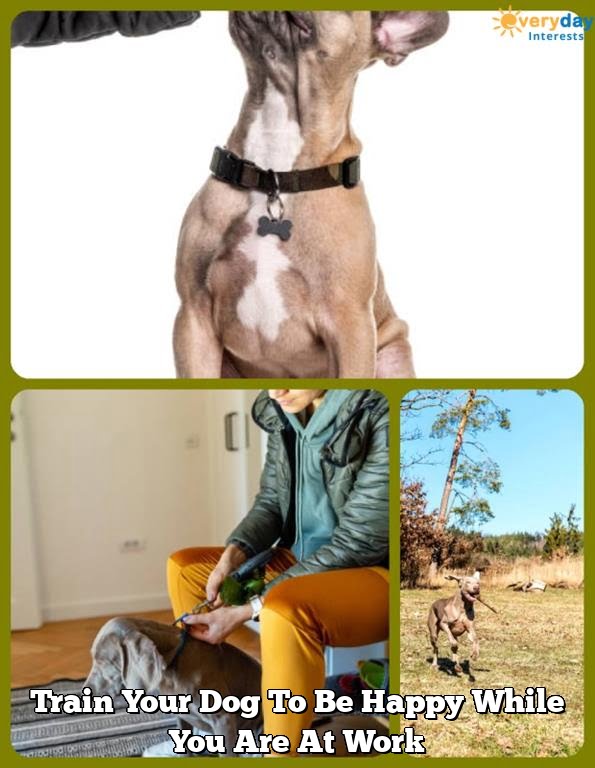Training your dog while at work can be a challenging task, but it is definitely achievable with the right strategies in place. By implementing consistent training methods and routines, you can help your furry friend learn new behaviors and sharpen existing skills even when you’re not around. This article will delve into the different ways you can train your dog effectively while balancing your work responsibilities.
One of the key benefits of training your dog while at work is the tremendous impact it can have on their behavior and overall well-being. Consistent training helps reinforce good habits, reduce negative behaviors, and enhance the bond between you and your pet. With a structured routine in place, your dog will feel more secure and confident in their environment, leading to a happier and healthier pup.
Setting up a routine for your dog while you’re away is essential for successful training sessions. Incorporating interactive toys, puzzles, and short training sessions into their daily schedule can provide mental stimulation and prevent boredom or destructive behavior.
Additionally, hiring a dog walker or pet sitter for mid-day exercise and training can break up their day and ensure they get the physical activity they need. By utilizing positive reinforcement techniques and monitoring progress closely, you can overcome common challenges in training while juggling work commitments.
Understanding the Importance of Consistency in Training
Training your dog while you’re at work can be a rewarding experience for both you and your furry companion. Consistency is key when it comes to training, as dogs thrive on routine and predictability. By setting clear expectations and sticking to a schedule, you can help your dog learn new behaviors more effectively. Here are some benefits of training your dog while you’re away:
- Building a stronger bond with your dog
- Improving their behavior and obedience
- Providing mental stimulation and preventing boredom
To ensure consistency in training, it’s important to establish a routine for your dog while you’re at work. This includes setting specific times for feeding, potty breaks, playtime, and training sessions. Dogs feel more secure and confident when they know what to expect, so try to stick to the same schedule every day. Here are some tips on how to train your dog while at work:
- Start by incorporating short training sessions into your morning and evening routine.
- Use interactive toys and puzzles to provide mental stimulation while you’re away.
- Hire a dog walker or pet sitter for mid-day exercise and training sessions.
Consistency in training also involves using positive reinforcement techniques to encourage good behavior. Rewarding your dog with treats, praise, or playtime when they exhibit the desired behavior helps reinforce that behavior in the future. It’s important to be patient and consistent with your training efforts, as dogs learn best through repetition and positive feedback.
Monitoring your dog’s progress is essential when training while at work. Keep track of their behaviors, responses to commands, and any challenges they may be facing. Adjust your training methods as needed based on their progress and feedback. Remember that every dog is unique, so be flexible in your approach and willing to adapt to their individual needs.
By understanding the importance of consistency in training and following these tips, you can effectively train your dog while at work and strengthen the bond between you and your furry friend.
Setting Up a Routine for Your Dog While You’re Away
Training your dog while you’re at work may seem like a daunting task, but establishing a consistent routine is key to success. Dogs thrive on routine and structure, so setting up a schedule for your furry friend can make training more effective. Start by creating a daily routine that includes designated times for feeding, exercise, training sessions, and mental stimulation activities.
To ensure that your dog stays on track with their training while you’re away, consider using interactive toys and puzzles that can keep them engaged and mentally stimulated. Toys that dispense treats or require problem-solving skills can help keep your pup entertained and prevent boredom-induced behaviors like chewing or excessive barking. Rotate these toys regularly to keep things interesting for your dog.
In addition to incorporating interactive toys into your dog’s daily routine, make sure to include short training sessions in the morning and evening. Even just 10-15 minutes of focused training each day can make a big difference in your dog’s behavior over time.
Use positive reinforcement techniques such as treats, praise, or playtime to reward good behavior and encourage learning. Consistency is key when it comes to training your dog while at work, so be patient and persistent in your efforts.
Utilizing Interactive Toys and Puzzles for Mental Stimulation
Dogs are intelligent creatures that require mental stimulation to keep them happy and healthy. This is especially important when they are left alone while their owners are at work. One effective way to provide mental stimulation for your dog while you’re away is by utilizing interactive toys and puzzles. These toys can keep your furry friend engaged and prevent boredom, which can lead to destructive behaviors like chewing or excessive barking.
Interactive toys come in a variety of forms, from treat-dispensing balls to puzzle games that challenge your dog’s problem-solving skills. By providing these toys before you leave for work, you can keep your dog occupied and mentally stimulated throughout the day. This not only prevents negative behaviors but also helps in keeping your dog’s mind sharp and engaged.
Incorporating interactive toys and puzzles into your dog’s daily routine is a great way to train them while you’re at work. These toys offer mental stimulation, encourage physical activity, and provide a fun way for your dog to pass the time when you’re not around.
Remember to introduce new toys gradually and supervise your dog initially to ensure they understand how the toy works. By incorporating these tools into your training routine, you can ensure that your canine companion stays happy and well-behaved even when you’re not at home.
Incorporating Short Training Sessions Into Your Morning and Evening Routine
Benefits of Morning Training Sessions
Training your dog in the morning before you head off to work can help set a positive tone for the day. This dedicated time allows you to focus on specific commands or behaviors that you want to work on with your dog. Whether it’s practicing basic obedience commands, such as “sit” or “stay,” or working on more advanced tricks, consistent morning training sessions can help keep your dog mentally engaged and ready to tackle the day ahead.
Benefits of Evening Training Sessions
After a long day at work, incorporating training sessions into your evening routine can provide a much-needed opportunity for both exercise and bonding with your pet. Consider setting aside some time after dinner to work on more challenging tasks or behaviors with your dog.
This can be a relaxing and rewarding way to wind down from the day while also reinforcing positive behaviors before bedtime. Through consistent evening training sessions, you can help reinforce the lessons learned throughout the day and continue making progress in your dog’s training journey.
Remember, consistency is key when it comes to training your dog while at work. By incorporating short training sessions into both your morning and evening routines, you can effectively communicate expectations to your furry companion and ensure that they receive the mental stimulation they need to thrive. With patience, dedication, and a well-thought-out training plan, you’ll be well on your way to successfully teaching your dog new skills-even while juggling a busy work schedule.
Hiring a Dog Walker or Pet Sitter for Mid-Day Exercise and Training
When you are at work for long hours, it can be challenging to ensure your dog gets the necessary exercise and training they need. This is where hiring a dog walker or pet sitter can be incredibly beneficial. These professionals can provide your furry companion with mid-day exercise, mental stimulation, and even continue their training while you’re away.
Benefits of Hiring a Dog Walker or Pet Sitter
By enlisting the help of a dog walker or pet sitter, you can rest assured that your dog is getting the attention and care they require during the day. Not only will they get the physical exercise they need to stay healthy and happy, but they will also have someone there to reinforce any training you’ve been working on.
Additionally, having regular interactions with another person can prevent feelings of loneliness or anxiety in your dog when you’re not around.
Choosing the Right Professional
When deciding on a dog walker or pet sitter, it’s crucial to do your research and find someone who is experienced, reliable, and trustworthy. Look for someone who has positive reviews from other pet owners and who understands how to handle different breeds and personalities.
Make sure to communicate your dog’s specific needs and any ongoing training requirements so that the professional can tailor their services accordingly. Remember, finding the right person can make all the difference in helping your dog thrive while you’re at work.
Remember, hiring a dog walker or pet sitter should complement your efforts in training your dog while at work. It’s essential to maintain open communication with them about your goals and expectations so that they can support your training routines effectively. With this additional support system in place, you’ll be able to give your furry friend the best care possible even when you’re not at home.
Using Positive Reinforcement Techniques to Reinforce Good Behavior
Training your dog while at work can be a beneficial way to ensure they stay mentally stimulated and well-behaved even when you’re not around. Using positive reinforcement techniques is a key component in reinforcing good behavior and encouraging your furry friend to continue learning and growing. Here are some ways on how to implement this method effectively:
- Start by identifying the specific behaviors you want to reinforce, such as sitting, staying, or coming when called.
- Reward your dog immediately after they exhibit the desired behavior with treats, praise, or playtime. This will help them associate the action with a positive outcome.
- Consistency is key in positive reinforcement training, so make sure to reward your dog every time they perform the desired behavior accurately.
In addition to using treats and rewards, another method of positive reinforcement is clicker training. By using a clicker to mark the precise moment your dog does something correctly, followed by a treat, you can help them understand which behaviors lead to a reward. This technique can be especially helpful when teaching more advanced commands or tricks.
- Keep training sessions short and frequent throughout the day to maintain your dog’s focus and enthusiasm.
- Monitor their progress closely and adjust your training methods as needed based on their responses.
- Stay patient and consistent with your training efforts, as it may take time for your dog to fully grasp new commands or behaviors.
By using positive reinforcement techniques consistently and thoughtfully, you can effectively reinforce good behavior in your dog while you’re away at work. Remember that each pup is unique, so tailor your training approach to suit their individual needs and personality.
Monitoring Progress and Adjusting Training Methods as Needed
As you train your dog while at work, it is essential to continually monitor their progress and adjust your training methods as needed. Just like humans, dogs can have good and bad days, so being flexible with your approach is key to success. Regularly assessing how your dog is responding to the training will allow you to make necessary changes to ensure they are learning effectively.
One way to monitor progress is by keeping a training journal. Note down what exercises or commands you worked on each day, how your dog responded, and any challenges or breakthroughs you encountered. This documentation will help you track patterns in your dog’s behavior and performance over time, allowing you to see what methods are most effective and where adjustments may be necessary.
In addition to tracking progress, it is important to be observant of any signs of frustration or confusion in your dog during training sessions. If you notice that they are becoming overwhelmed or disinterested, it may be time to switch up the routine or simplify the exercises. Remember that every dog is different, so being attuned to their individual needs and learning style will contribute greatly to their success in training while you’re at work.
| Training Method | Response |
|---|---|
| Interactive toys | Engaged and stimulated |
| Morning training session | Responsive and eager |
| Pet sitter mid-day exercise | Energetic and well-exercised |
Troubleshooting Common Challenges in Training While at Work
Training your dog while you’re at work can be a rewarding experience that benefits both you and your furry friend. However, it’s essential to understand the importance of consistency in training to see results. Setting up a routine for your dog while you’re away will help them adjust to training sessions even when you’re not around. By utilizing interactive toys and puzzles for mental stimulation, you can keep your dog engaged and focused during training time.
Incorporating short training sessions into your morning and evening routine is another effective way to train your dog while balancing work commitments. Hiring a dog walker or pet sitter for mid-day exercise and training can provide additional support and ensure that your dog gets the attention they need throughout the day. Using positive reinforcement techniques to reinforce good behavior will help strengthen the bond between you and your pet.
Monitoring progress and adjusting training methods as needed is crucial in ensuring that your dog continues to learn and grow. By troubleshooting common challenges in training while at work, such as distractions or lack of motivation, you can overcome obstacles together with patience and consistency. Remember, with dedication and effort, you can successfully train your dog while juggling work responsibilities.
Frequently Asked Questions
How Do You Train Your Dog if You Work?
Training a dog while working requires time management and consistency. Utilizing short training sessions before or after work is beneficial. Consider hiring a dog walker or enrolling in daycare for socialization.
Can a Dog Be Left Alone for 8 Hours?
Leaving a dog alone for 8 hours can be challenging, especially for puppies or high-energy breeds. It’s essential to provide mental stimulation, such as puzzle toys or interactive feeders, to alleviate boredom.
Is It OK to Leave Dog in Crate for 8 Hours?
Leaving a dog in a crate for 8 hours is not advisable unless necessary for potty training or safety reasons. It’s crucial to ensure the crate is appropriately sized, comfortable, and that the dog has access to water and toys.

Welcome to the blog! I am a professional dog trainer and have been working with dogs for many years. In this blog, I will be discussing various topics related to dog training, including tips, tricks, and advice. I hope you find this information helpful and informative. Thanks for reading!





